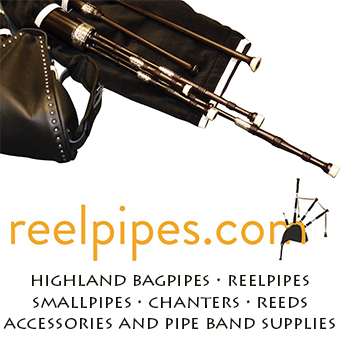
Continuing an instructive article written by David V. Kennedy of Sacramento, California.
The profile
If you take a single chanter reed blade and look at it so that it has the shape of the shaper shown earlier, you are looking at its ‘shape’. Now take the blade and put it flat on a table. Lift it from that horizontal position, and keeping it horizontal look at the edges

of the blade, or what could be said to be the side view. This is the ‘profile’. When the two blades are joined on a staple and tied on there, we then have the total profile of the reed. The ideal is to balance each blade with respect to its profile, but often this just does not happen and yet the reed will play quite well.
There are, in general, two distinct types of profiles and they’re shown below:

Profile A is much less severe than profile B. Of course the drawings do exaggerate the profiles; but A is a gradual, transitional scrape toward the ends of the blades and in B there is an abrupt thinning of the blades which starts at about one third of the way up from the topmost tie-on or cord or hemp. Some chanter reeds have profiles somewhere between A and B.

To get the total profile we have to put the two single reed-blades onto a holder, or ‘tube’ or ‘staple’. This staple has specific dimensions and can be made either by machine or by hand. The material of the staple can be silver, copper or brass … but the most often used material is sheet copper.
Before the single reed-blades are tied onto the staple, they are briefly soaked in water, but an occasional reedmaker will use alcohol. The point of wetting up the blades is to try to ensure that they won’t split as they are being tied on, and the usual reason for their splitting is that they have to be bent around the shape of the staple. So wet cane is easier to bend than dry cane.



Tying on the reed-blades
The single blades are roughly aligned by hand on the staple that is inserted into a holding mandrel. My own holding mandrel is a wee electrical screwdriver with the tip ground to appropriate shape. I should say here that some reedmakers do not use the same technique as I do, but whatever technique is used has basically the same principles: to fit the blades to the staple.


I hold the mandrel in my left hand and can also hold the reed- blades onto the staple, all done with one hand. The tying-in cord is tied to a banister or other firm object and stretched. The right hand takes the cord and starts to wind the stretched cord onto the tails of the reed-blades, until the entire tails are covered. Now, most reedmakers start the winding at the top of the tails; come down the tails and then complete by taking several turns towards the tops of the tails. The blades must be tied onto the staple tightly enough to

close the sides of the blades so as to prevent air leaks. This is why I start at the op and work down but very few reedmakers use that approach for pipe-reeds. It really doesn’t matter which approach you use provided that you get the reed tied on securely. The actual way to wind on the tying hemp, string or cord is too involved to describe here; but any oboe reedmaker or pipe-reed maker can show you how to do it.
After the reed is tied onto the staple, the cord is shellacked or varnished so as to prevent moisture penetration and to prevent the cord from slipping.
Just where you take your first windings depends on whether or not you are trying to fit the reed to a very old chanter or to a relatively modern one.
I like to take the first tie-in at about ¾ inch from the top of the reed, if, for instance I am going to play the reed in a chanter made within the last 20 years; but if I want to put the finished reed in a pre-World War One Peter Henderson chanter I try to get an effective length of 7/8ths inch instead of 6/8ths. With the latter 7/8ths in reeds, I also

shape the tips slightly wider than with the 6/8ths reeds. I hasten to add that a number of reedmakers do not exceed 5/8ths inch in effective length. As a reedmaker cum piper I do not care for such short reeds because I cannot cut the tips off if I find it necessary to do so when I am ‘pitching’ the reed. In other words, there is no lee- way with such short reeds.
* From the April 1987 Piping Times.


